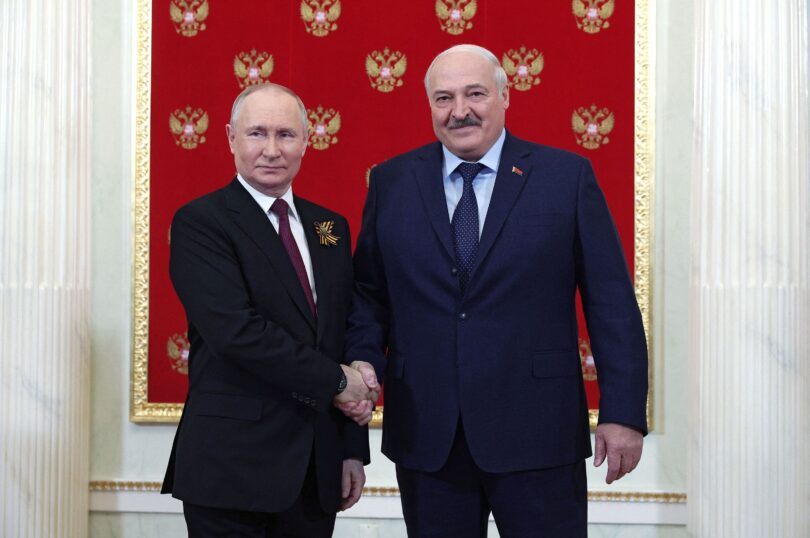David A. Andelman
The last time there was a single nuclear weapon outside of Russia, in the swath of Europe dominated by the Soviet Union and its Warsaw Pact allies, was on June 1, 1996. That’s when the final nuclear warhead, deployed in Ukraine by the now-dismantled Soviet Union, was transferred to back to Russia – which, in theory, owned and controlled all of them.
This transfer was the product of an agreement between presidents Bill Clinton, Boris Yeltsin and Ukraine’s Leonid Kuchma, that all such weapons would be transferred to Russia for elimination, and in return, Ukraine would receive iron-clad assurances of security and compensation. That agreement was clearly breached the moment Russian troops rolled across Ukraine’s frontiers in February 2022, if not by the seizure of Crimea by Russia in March 2014.
Now, there is a new breach, a new threat and a new risk of destabilization. On June 14, Belarus President Alexander Lukashenko announced that his country had taken delivery of the first of a collection of tactical nuclear weapons from Russia. While designed only for limited use on local battlefields, he said some are three times more powerful than the atomic bombs the US dropped on Hiroshima and Nagasaki, devastating both cities in 1945. Far be it for me to shout, “Chicken Little, the sky is falling.” But consider the scenario. Belarus has both a nuclear arsenal and a president who for decades has quietly played the role of Putin’s lap dog. And indeed, in a press conference Thursday in Minsk, he did claim to being in lockstep with Putin – adding that the nuclear weapons were for defensive purposes only. At the same time, there is still broad fear in the West and in Ukraine that this purpose could shift on a dime. The weapons themselves certainly have both defensive and offensive capabilities, depending on how their masters make use of them.
In the same press conference, Lukashenko nodded to the fact that those nuclear weapons were under Russia’s control. He said that were Russia to use nuclear weapons, “I am sure that it would consult with its closest ally,” adding that the weapons “are under reliable protection.” In other words, the button is not Lukashenko’s to push. Meanwhile, the nuclear threat is expected to be high on the agenda of the summit of NATO leaders, including President Joe Biden, which will convene next week in Vilnius, capital of Lithuania, barely 20 miles from the tense 420-mile border this NATO member shares with Belarus. The agenda could also include the potentially explosive issue of NATO membership for Ukraine. In a joint news conference in Brussels with NATO secretary general Jens Stoltenberg last month, Estonia’s prime minister Kaja Kallas called Belarus “unpredictable and dangerous.” In turn, with a preview of the NATO summit, Stoltenberg added, “We must keep our defenses strong to send a clear message to Moscow and Minsk that NATO protects every inch of allied territory.”
Especially with nukes now deployed right next door. There are, functionally, few remaining restraints on the arsenals of any nuclear power – not least the US and Russia, which together account for 90% of the nuclear weapons on earth. But above all, what seems to be in a degree of jeopardy is a concept that kept the nuclear peace for a half century or more – throughout the Cold War and a host of regional conflicts – a concept called Mutually Assured Destruction or MAD. Now largely forgotten or ignored, it was during the Cold War that the concept of MAD came into broad use to define the precarious balance between the then two, paired superpowers – the US and the Soviet Union. This concept held that the fear of certain retaliation and utter destruction of their nation, if not all life on earth, would inevitably follow the use of any such weapons. This clear and present fear would preclude their use and was the ultimate guarantor of peace. The question today is whether the growing pace of threats from Russia of the possible use of devastating nuclear weapons against Ukraine could mean the end of such a concept’s viability.
With the transfer of the weapons to Belarus, the UN’s disarmament chief, Izumi Nakamitsu, warned the Security Council that the risk of nuclear weapons use was “higher than at any time since the Cold War.” So whatever happened to MAD? It hasn’t exactly gone away, but many of the restraints may be coming undone.
There are, for instance, no more nuclear arms control treaties still extant and functioning between the US and Russia. Former President Donald Trump pulled out of the Intermediate-Range Nuclear Forces (INF) Treaty in August 2019. In February 2021, at the start of the Biden administration, the only other remaining treaty between the two powers, known as New START, was extended for five years until 2026. In February 2023, Russian President Vladimir Putin announced he was “suspending” his country’s participation. Secretary of State Antony Blinken promptly calling this action “deeply unfortunate and irresponsible.”
Indeed, about the only real agreement remaining is MAD – then and now unwritten but still viable, though depending on the perhaps elusive good sense of the leaders of the two nuclear superpowers. So, are we returning to the days of duck-and-cover, when, as I still recall as though it were yesterday, an air-raid drill sounded, we would crouch beneath our little wooden desks in kindergarten and cover our heads? As though that would preserve us from the inferno of a nuclear blast? “The condition of MAD still exists between the US and Russia, the consequence of all the nukes each side has,” Michael Mandelbaum, professor emeritus of American foreign policy at Johns Hopkins School of Advanced International Studies, one of the leading experts on MAD told me in an email.
“In the early ’60s American officials worried that the Soviet Union would launch a less-than-all-out attack, reasoning that the US would not respond in a way that might trigger Armageddon,” he said. Today, Mandelbaum, author of “The Four Ages of American Foreign Policy: Weak Power, Great Power, Superpower, Hyperpower,” continued, “It’s conceivable that Putin might calculate that he could use a nuke against Ukraine and get away with it. I have the impression that the US government is well aware of this possibility and has communicated to the Russian side the various non-nuclear steps NATO could take in retaliation.” So much depends on the view of one man – Vladimir Putin. But he has more to gain for himself, not to mention his people or humanity (for which he seems to have less regard) by hewing to the spirit, if not the letter, of MAD. Keeping the nuclear genie contained, rather than unleashing it on a wing and a prayer, is truly the best, indeed, the only path. Somehow, he must be convinced this is also in his own best interest.
CNN







